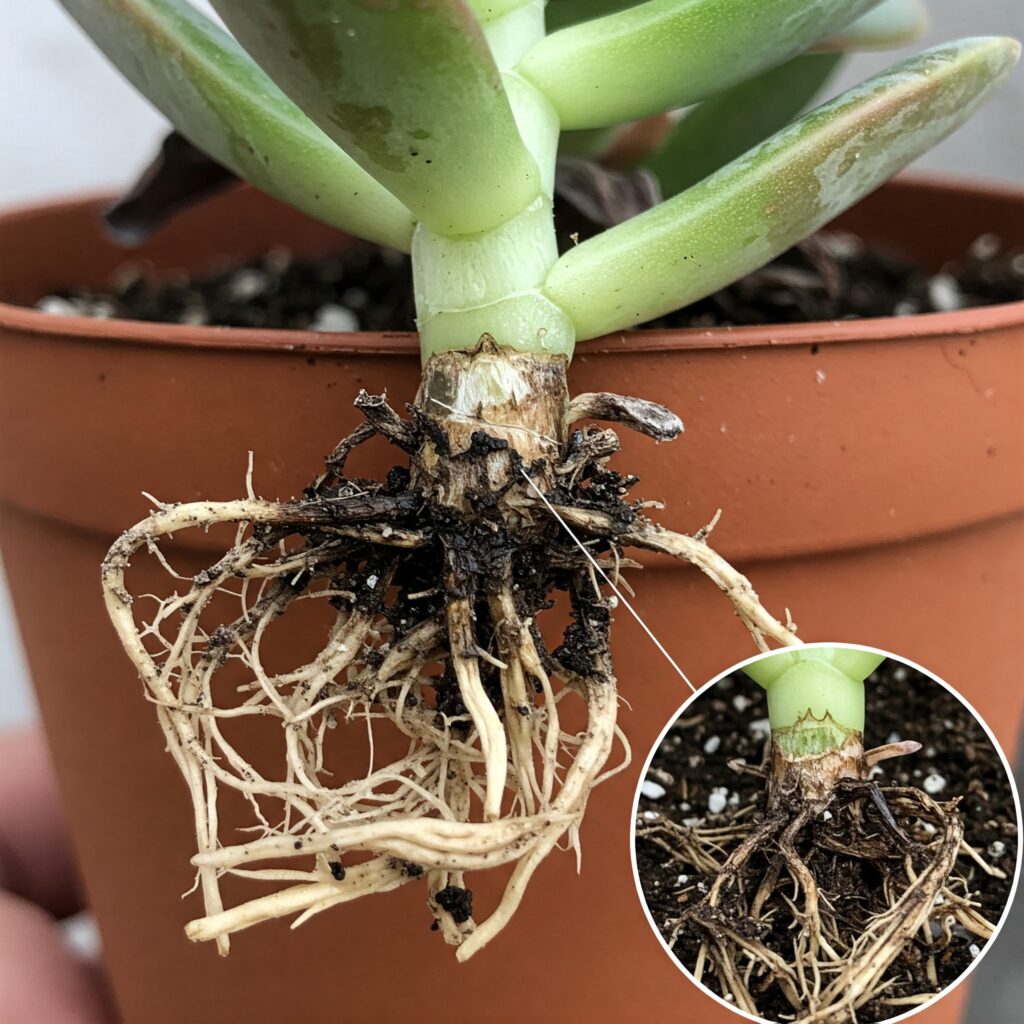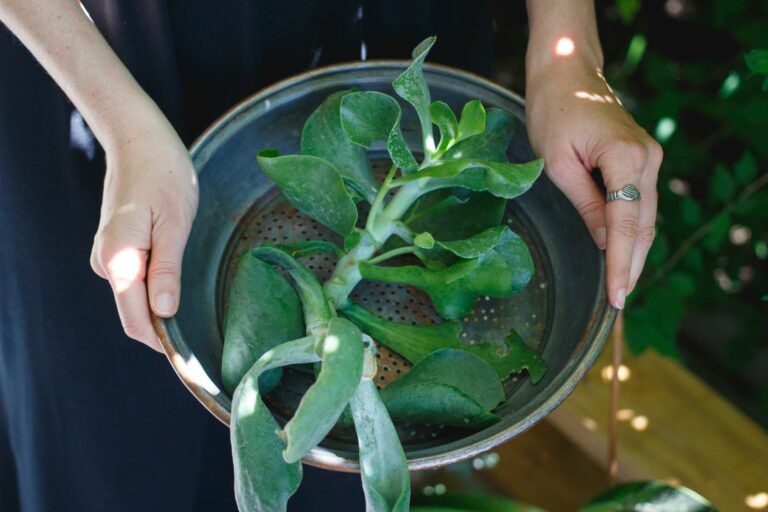As a gardener, you have come across root rot in plants. It’s a major problem that has killed more plants than people care to admit. That’s because most of them don’t know what root rot in succulents looks like or how it affects the plant.

But how will you know if your plant hasn’t been affected yet? Knowing what root rot is can favor you when the plant starts to show signs. In most instances, you will find the first significant signs on the leaves. From there, you can check the roots.
What is root rot?
Root rot is a condition that affects your plant’s roots, whereby they decay or rot, causing them to die if not treated. So, what causes succulent root rot? The most common cause of succulent rotting is overwatering. People must remember that succulents store their own water, and adding extra water causes problems.
How does overwatering affect the roots?
When you give the plant excess water, it absorbs the amount it needs, leaving the rest on the soil. The soil becomes waterlogged, closing the pores that allow air circulation. Since the roots require proper air circulation, they start to stress because they lack fresh air. Once the stress kicks in, they stop working, which makes them weak. A weak plant is easily affected by fungi present in the soil. The fungi then cause root rot in succulents.

This article discusses the cause of succulent rotting and how to identify it and treat it before it kills your succulents.
The causes of root rot in succulents
Most of the causes are affiliated with the plant getting too much water. Here is a breakdown of how different factors can cause succulent root rot.
Overwatering
As you have seen above, overwatering is the primary cause of root rot in succulents. It involves giving the plant excess water.
People give a plant more water because they don’t know the amount of water a plant needs. To be sincere, nobody can tell when the plant has enough water, but you can quickly tell when you are giving it excess water.
Excess water in the soil clogs the soil, preventing air circulation into the roots. If the roots don’t get fresh air, they will start to rot.

You can identify root rot from overwatering when;
- The succulent becomes translucent or light in color
- The succulent becomes soft, mushy, and squishy
- It starts to fall off due to the extra weight.
The cold winter season
Succulents are hardy, but sometimes it is hard for a plant to survive in the winter cold. Leaving them outdoors in frosty and cold temperatures will lead to succulent rotting. Cold temperatures tend to cause stress to a plant. The stress can make it shut down and stop growing.
Avoid moving them outdoors during the winter. Also, you can provide them with a grow light to improve their growing conditions during winter.
Poor soil drainage
The soil you use for your plants should have good drainage and water retention capacity. So, if the water stays on top of the soil for a long time, it has poor drainage, which can lead to root rot in succulents.

Soil with good drainage should absorb the water immediately after you pour it. If extra water remains, it should be able to drain off the drainage holes in the pot. To know if your soil has good drainage, pour water into it until it is stagnant on top, then leave for about 30 mins to check if it’s still on top.
If water is stagnant, avoid that soil and purchase fresh potting soil. Also, ensure your container has drainage holes at the bottom to drain off excess water.
Fungi and bacteria
It’s hard to know when bacteria and fungi are attacking your plant. In most cases, you will notice after it has happened to the roots.
However, ensure the soil has proper aeration to prevent the growth of bacteria and fungi.
How to identify succulent root rot
Check the roots
When you remove your succulent from the pot and find that some roots have turned dark brown or black, that is a sign of root rot.

Succulents have a tolerance for uprooting, so you can remove them from the soil if you think they have a problem. Always be gentle when uprooting. So, how do you uproot the succulents?
Using a small shovel, dig around the plant to loosen the soil. Move the plant in a circle gently to loosen the roots from the soil. Then turn the container upside down and hold the plant in your hand when it detaches from the soil.
Shake off the soil around the roots to check the color. Healthy roots are white or yellow. If they are dark brown or black, slimy and wet when you touch them, then you have a problem. Check if the whole root system is affected. Don’t try to save it if the whole root system is rotten.
If it has healthy roots, you can try to treat it. Use a sharp knife to cut off the affected roots and any other affected parts of the plant. Let the plant dry off excess water, and then repot in fresh soil.
Check the stems
Another sign of root rot is when the stems start to rot. Succulent stem rot is not common, but it can affect your plant if the rot is at its advanced stages.
You will notice dark brown or black spots around the stem. Some areas of the stem might be swollen. If you notice that, uproot your plant and check how far the rotting has gone.
Unhealthy leaves
Another way to identify root rot in succulents is through the leaves. When it happens, it affects leaves which become unhealthy and start drooping.
The first sign is the lower leaves turn yellow and pale. After some time, they become mushy, and if nothing is done, they die. When all the leaves of a succulent turn yellow at the same time, that can be due to nutrient deficiency. Overwatering affects the lower leaves; then, it moves to the upper leaves.
How to treat root rot in succulents
Now that you know how to identify succulent rotting, it’s time for you to know how to treat it. Here are some ways you can fix the problem.

Let the water dry out.
The first way to fix overwatering is to stop giving the plant water. You can do this if the rotting is in its early stages and only a few roots are affected. It’s not the best technique because you don’t know how much of your plant is affected.
So, you can uproot it to check the rotting. Let the plant dry for a few days before you return it to the soil. That way, your plant is dry, and the rotten roots are dead.
Add water sparingly to make the soil damp, and leave it without water for two weeks. It will ensure the plant heals completely.
Trim the infected parts of the succulent.
This process involves cutting off any affected part of the plant, including leaves. That’s because if you on;y remove affected roots and leave leaves, the affected leaves will continue affecting other parts.
Use a sharp and sterilized tool to cut the affected parts. After cutting, let the plant dry in a partly shaded area for a few days.
Repot the plant in fresh soil to avoid contamination. You can also use a different pot or sterilize the existing container to remove bacteria and fungi.

Propagating the healthy part.
If the succulent root has advanced, you can cut the affected parts and propagate the healthy part. With propagation, you can use healthy stems or leaves. The roots will grow when you propagate them.
Use a new pot and fresh potting soil when propagating. Cut the healthy part from the plant and push it into the soil mixture. Leave it without water for a week, and then you can start watering sparingly. Ensure you give it enough water so that the roots can develop faster.
Dust succulent roots in sulfur
It’s believed that sulfur can protect roots from fungi and bacteria. Sulfur is an acid, so when used, it acidifies the soil. Tiny microorganisms tend to die from acid soil.
So, it can be an excellent way to keep away bacteria and fungi, but it can also kill beneficial organisms in the soil. Also, if you still overwater your plant, this solution will not be effective.
It works by applying it on the roots before repotting. Ensure the roots are dry when applying sulfur.
Conclusion
From this, you know that overwatering is the main cause, and you can save yourself the stress of root rot in succulents by giving the plant enough water or using a well-drained soil with high retention capacity.
But, if you have this problem, try to solve it quickly before it spreads to other parts of the plants or worse, it kills the plant.






